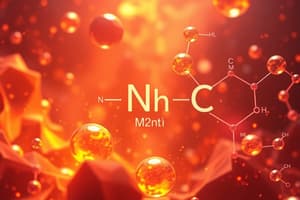Podcast
Questions and Answers
Which subatomic particle is primarily responsible for determining the chemical properties of an atom?
Which subatomic particle is primarily responsible for determining the chemical properties of an atom?
- Electrons, particularly valence electrons, due to their role in chemical bonding. (correct)
- Neutrons, because they contribute to the atom's mass and stability.
- A combination of protons and neutrons in the nucleus.
- Protons, because they define the element and its nuclear charge.
How does the formation of an ionic compound typically affect the charge of the participating atoms?
How does the formation of an ionic compound typically affect the charge of the participating atoms?
- Both atoms become negatively charged (anions).
- Both atoms remain neutral as electrons are shared equally.
- Both atoms become positively charged (cations).
- One atom becomes positively charged (cation), and the other becomes negatively charged (anion). (correct)
What principle must be adhered to when balancing chemical equations?
What principle must be adhered to when balancing chemical equations?
- The sum of the coefficients on one side must equal the sum of the coefficients on the other side.
- The total charge must be the same on both sides of the equation, regardless of the number of atoms.
- The total number of molecules must remain constant on both sides of the equation.
- The number of atoms of each element must be the same on both sides of the equation. (correct)
In a double displacement reaction, what is the driving force that typically leads to the formation of products?
In a double displacement reaction, what is the driving force that typically leads to the formation of products?
What distinguishes molecular compounds from ionic compounds in terms of electron behavior?
What distinguishes molecular compounds from ionic compounds in terms of electron behavior?
How does the presence of a multivalent metal affect the naming conventions of ionic compounds?
How does the presence of a multivalent metal affect the naming conventions of ionic compounds?
In a Bohr-Rutherford diagram, what do the concentric circles surrounding the nucleus represent?
In a Bohr-Rutherford diagram, what do the concentric circles surrounding the nucleus represent?
During a chemical reaction, if heat is released, what type of reaction is it?
During a chemical reaction, if heat is released, what type of reaction is it?
Why do polyatomic ions act as a single unit in chemical reactions?
Why do polyatomic ions act as a single unit in chemical reactions?
What are the typical products of a complete combustion reaction?
What are the typical products of a complete combustion reaction?
Flashcards
Protons
Protons
Positively charged particles located in the nucleus of an atom.
Neutrons
Neutrons
Neutral particles (no charge) located in the nucleus of an atom.
Electrons
Electrons
Negatively charged particles that orbit the nucleus in shells or energy levels.
Valence Electrons
Valence Electrons
Signup and view all the flashcards
Cations
Cations
Signup and view all the flashcards
Anions
Anions
Signup and view all the flashcards
Multivalent Metals
Multivalent Metals
Signup and view all the flashcards
Polyatomic Ions
Polyatomic Ions
Signup and view all the flashcards
Chemical Reaction
Chemical Reaction
Signup and view all the flashcards
Balancing Equations
Balancing Equations
Signup and view all the flashcards
Study Notes
Atoms and Atomic Structure
- Atoms consist of protons, neutrons, and electrons.
- Protons are positively charged and found in the nucleus.
- Neutrons have no charge and reside in the nucleus.
- Electrons are negatively charged and orbit the nucleus in shells/energy levels.
- Bohr-Rutherford diagrams show electron arrangement in atoms/ions, displaying the nucleus and electron shells.
- Valence electrons are in the outermost shell that form chemical bonds.
Ionic and Molecular Compounds
- Ionic compounds form between a metal and a non-metal through electron transfer.
- Cations are positive ions, resulting from electron loss.
- Anions are negative ions, resulting from electron gain.
- Ionic compounds are named by combining ion names.
- Formulas are written to ensure charge neutrality based on ion charges.
- Multivalent metals can form ions with varying charges/oxidation states.
- Polyatomic ions are groups of atoms with a net charge, acting as a single unit.
- Molecular compounds form between non-metals by sharing electrons.
Chemical Reactions
- A chemical reaction is a process where reactants change into products.
- Balancing equations ensures the same number of atoms for each element on both sides, following the law of conservation of mass.
Types of Reactions
- Synthesis (combination): A + B → AB
- Decomposition: AB → A + B
- Single displacement: A + BC → AC + B
- Double displacement: AB + CD → AD + CB
- Combustion: A fuel reacts with oxygen to yield carbon dioxide and water.
Studying That Suits You
Use AI to generate personalized quizzes and flashcards to suit your learning preferences.



